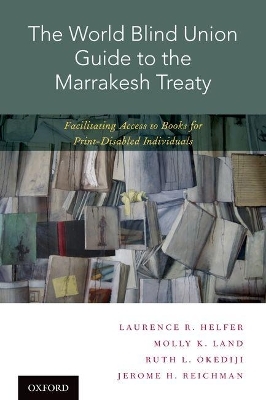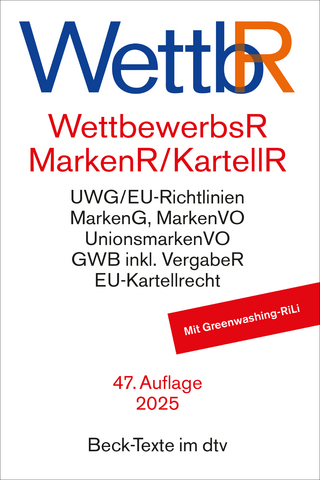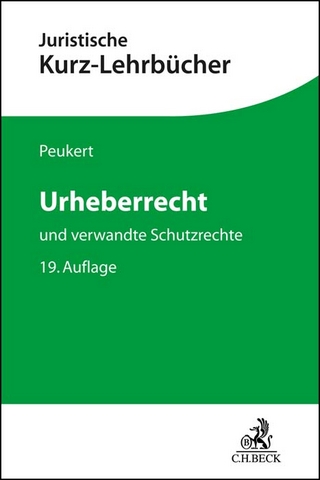
The World Blind Union Guide to the Marrakesh Treaty
Oxford University Press Inc (Verlag)
978-0-19-067964-4 (ISBN)
"The Marrakesh Treaty to Facilitate Access to Published Works for Persons Who Are Blind, Visually Impaired, or Otherwise Print Disabled" is a watershed development in the fields of intellectual property and human rights. As the first international legal instrument to establish mandatory exceptions to copyright, the Marrakesh Treaty uses the legal and policy tools of copyright to advance human rights. The World Blind Union Guide to the Marrakesh Treaty offers a comprehensive framework for interpreting the Treaty in ways that enhance the ability of print-disabled individuals to create, read, and share books and cultural materials in accessible formats. The Guide also provides specific recommendations to government officials, policymakers, and disability rights organizations involved with implementing the Treaty's provisions in national law.
Laurence R. Helfer is Harry R. Chadwick, Sr. Professor of Law at Duke University Law School. He is an expert in international law and institutions, international adjudication, human rights (including LGBT rights), and international intellectual property law and policy. He is co-director of Duke Law's Center for International and Comparative Law and a Senior Fellow with Duke's Kenan Institute for Ethics. He also serves as a Permanent Visiting Professor at the iCourts: Center of Excellence for International Courts at the University of Copenhagen. Molly K. Land is Professor of Law and Human Rights at the University of Connecticut School of Law and Human Rights Institute. She also serves as Associate Director of the Human Rights Institute and Director of the LL.M. in Human Rights and Social Justice. Drawing on her human rights expertise and background as an intellectual property litigator, Professor Land's scholarship focuses on the effect of new technologies on human rights fact-finding, advocacy, and enforcement, as well as the role of human rights norms and framing strategies in organizing around human rights issues. Ruth L. Okediji is McKnight Presidential Professor and William L. Prosser Professor of Law at the University of Minnesota Law School. Her scholarship focuses on issues of innovation policy, economic development, and global knowledge governance in the context of international institutions and public international law. Jerome H. Reichman is Bunyan S. Womble Professor of Law at Duke University Law School. He has written and lectured widely on diverse aspects of intellectual property law, including comparative and international intellectual property law and the connections between intellectual property and international trade law.
Acknowledgments
Foreword
Executive Summary
Introduction
1. Guiding Principles for the Marrakesh Treaty
1.1. The Marrakesh Treaty at the Crossroads of Human Rights and Intellectual Property
1.1.1. The International Human Rights Regime
1.1.2. The International Intellectual Property Regime
1.1.3. Conflict or Coexistence Between the Regimes?
1.1.4. Using Copyright Tools to Achieve Human Rights Ends
1.2. Interpretive Principles for the Marrakesh Treaty
1.2.1. Emphasize Object and Purpose
1.2.2. Adapt the Marrakesh Treaty to Changing Conditions
1.2.3. Promote Consistency with the CRPD
1.2.3.1 Background to the CRPD
1.2.3.2. Central Principles of the CRPD
1.2.3.3. Consultations with Stakeholders
2. The Legal and Policy Choices in the Marrakesh Treaty
2.1. Copyrighted Works Covered by the Marrakesh Treaty
2.2. Accessible Format Copy
2.3. Authorized Entities
2.3.1. Introduction and Overview
2.3.2. Types of Authorized Entities
2.3.2.1. Entities Providing Services to Beneficiaries
2.3.2.2. Government Recognized Entities
2.3.3. The Practices of Authorized Entities
2.4. Beneficiary Persons
2.4.1. Introduction and Overview
2.4.2. Categories of Beneficiary Persons
2.4.2.1. Blindness
2.4.2.2. Visual Impairment or Perceptual Disability
2.4.2.3. Physical Reading Disability
2.4.3. Defining Beneficiary Persons in Implementing Legislation
2.5. Exceptions and Limitations to Copyright in National Law
2.5.1. Introduction and Overview
2.5.2. Obligations of Article 4(1)
2.5.2.1. Mandatory Exceptions and Limitations
2.5.2.2. Non-Mandatory Exceptions and Limitations
2.5.3. Modes of Implementing Article 4(1)
2.5.3.1. Article 4(2) - The Safe Harbor Option
2.5.3.1.1. The Safe Harbor for Authorized Entities
2.5.3.1.2. The Safe Harbor for Beneficiary Persons
2.5.3.1.3. Implications of the Safe Harbor Options
2.5.3.2. Article 4(3) - The Sui Generis Option
2.5.4. E&Ls for the Translation of Copyrighted Works
2.5.5. The Commercial Availability Option
2.5.6. The Remuneration Option
2.6. Cross-Border Exchange and Importation of Accessible Format Copies
2.6.1. Introduction and Overview
2.6.2. Substantive Obligations of Articles 5 and 6
2.6.2.1. Article 5 - Export of Accessible Format Copies
2.6.2.2. Article 6 - Import of Accessible Format Copies
2.6.3. Modes of Implementation of Articles 5 and 6
2.6.3.1. Article 5(2) - The Safe Harbor Option
2.6.3.1. Article 5(3) - The Sui Generis Option
2.6.4. Exhaustion of Rights
2.6.5. Implementation of Article 6
2.6.6. Cross-Border Issues Not Addressed in the Marrakesh Treaty
2.7.. Technological Protection Measures
2.7.1. Introduction and Overview
2.7.2. Analysis
2.8.. Three-Step Test
2.8.1. Policy Rationales of the Three-Step Test
2.8.2. The Three-Step Test and E&Ls for the Blind
2.8.3. Applying the Three-Step Test to the Marrakesh Treaty
2.8.4. The Three-Step Test and International Human Rights Law
3. Putting the Marrakesh Treaty Into Practice in National Law
3.1. Create Legal Remedies
3.2. Empower National Institutions
3.2.1. Human Rights Institutions
3.2.2. Intellectual Property Institutions
3.2.3. Linking to the Marrakesh Treaty Assembly
3.3. Undertake Enforcement Activities
3.3.1. Monitor Rights
3.3.2. Enforce Legal Remedies
3.3.3. Create a National Plan of Action
3.3.4. Engage in Training and Outreach
3.4. Engage in National Reporting
3.4.1. UN Treaty Bodies
3.4.2. UN Charter Bodies
3.4.3. UN Special Procedures
Conclusion
Appendices
World Intellectual Property Organization, Extraordinary General Assembly: A Decision Text, December 18, 2012
Marrakesh Treaty to Facilitate Access to Published Works for Persons Who Are Blind, Visually Impaired, or Otherwise Print Disabled (adopted on June 27, 2013, entered into force on September 30, 2016)
Signatories and Contracting Parties to the Marrakesh Treaty (as of October 31, 2016)
Convention on the Rights of Persons with Disabilities (CRPD) and Optional Protocol to the CRPD (adopted on December 13, 2006, entered into force on May 3, 2008)
Signatories and Contracting Parties to the Convention on the Rights of Persons with Disabilities (as of October 31, 2016)
Berne Convention for the Protection of Literary and Artistic Works, last revised at Stockholm, July 14, 1967 (without Appendix)
Index
| Erscheinungsdatum | 30.06.2017 |
|---|---|
| Verlagsort | New York |
| Sprache | englisch |
| Maße | 213 x 142 mm |
| Gewicht | 371 g |
| Themenwelt | Recht / Steuern ► EU / Internationales Recht |
| Recht / Steuern ► Wirtschaftsrecht ► Urheberrecht | |
| Sozialwissenschaften ► Politik / Verwaltung | |
| Sozialwissenschaften ► Soziologie | |
| ISBN-10 | 0-19-067964-6 / 0190679646 |
| ISBN-13 | 978-0-19-067964-4 / 9780190679644 |
| Zustand | Neuware |
| Haben Sie eine Frage zum Produkt? |
aus dem Bereich


